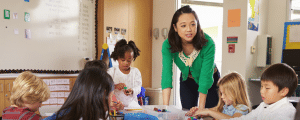Meeting Students on Their Own Cultural Turf
CompetencyWorks Blog
This post originally appeared at Getting Smart on April 7, 2018.
 As teachers, we are hardwired to look favorably upon students who remind us of ourselves. It is healthy to reflect on this for a moment, as this is something that most teachers have rarely paused to consider. For this reason, Columbia University Associate Professor Chris Emdin’s New York Times bestselling book For White Folks Who Teach in the Hood…and the Rest of Y’a’ll Too: Reality Pedagogy and Urban Education may cause unease in some readers. His argument is that it is within this place of discomfort that real transformation occurs.
As teachers, we are hardwired to look favorably upon students who remind us of ourselves. It is healthy to reflect on this for a moment, as this is something that most teachers have rarely paused to consider. For this reason, Columbia University Associate Professor Chris Emdin’s New York Times bestselling book For White Folks Who Teach in the Hood…and the Rest of Y’a’ll Too: Reality Pedagogy and Urban Education may cause unease in some readers. His argument is that it is within this place of discomfort that real transformation occurs.
Emdin proposes a reality pedagogy. “Reality pedagogy is an approach to teaching and learning that has a primary goal of meeting each student on his or her own cultural and emotional turf.” He invites teachers to really get to know their students’ communities and cultures. Every student has different realities from their teacher, but this is especially the case if the teacher is from another ethnic, racial, cultural and socioeconomic background. This uniqueness of each student’s experience is a fundamental, and often overlooked, piece of the teaching and learning puzzle.
Emdin refers to the Seven Cs of teaching:
- Co-generative dialogue which is structured like hip-hop cipher.
- Co-teaching so students and their peers can teach the class.
- Cosmopolitanism allows students to feel that they are responsible for the day to day operation of the class.
- Context is learning the environment the students come from and how it can be incorporated into the classroom.
- Content is realizing that as an adult and a teacher you don’t know all the answers.
- Competition is essentially about turning learning into a game.
- Curation is when teachers research their own practice, video themselves teaching and ask students for feedback.
This viral video of Barry White’s daily special handshakes with his students is a great example of Cosmopolitanism and Context.
Reality pedagogy is grounded in what educational researcher Gloria Ladson-Billings calls culturally relevant pedagogy. It centers on student voice and teacher agency, and it doesn’t take its cues from “classroom experts” who are far removed from the reality of schools. Reality pedagogy enables teachers to develop approaches that meet the specific needs of the students who are sitting right in front of them every day.
Reality pedagogy is about knowing your students, knowing their worlds, being genuinely interested, and being prepared to be uncomfortable. It is all about the culture of the classroom. Teachers have to meet students where they are at. Understanding students’ backgrounds is essential to teach them well. If we are ignorant of cultural norms, we can’t tap in.
It isn’t about teaching to an assessment task or teaching to the curriculum. Teaching to an exam and strictly following a curriculum makes it too easy to become emotionally disconnected from students. Instead, it’s about teaching directly to the students. It requires privileging the voice of the student. The ability to connect with students is more important than the ability to produce a great lesson plan.
Reality pedagogy is not just for the US hoods. It applies in every context throughout the world. In my Australian context there are clear connections with indigenous cultures and ethnic minorities. The bottom line is that it comes down to helping adults clear space for kids’ natural curiosity to make sense of their own worlds. What types of student communities are in your classroom? How should your students be treated differently based on their background?
See also:
- Designing for Equity: Leveraging Competency-Based Education to Ensure All Students Succeed
- Why True Equity in Learning Depends on Proactive, Not Reactive, Design
- Cultural Responsiveness Starts in the Principal’s Office
Cameron Paterson is a Getting Smart Staff Writer, and is the Head of Learning and Teaching at Shore School in Australia. Follow him on Twitter: @cpaterso